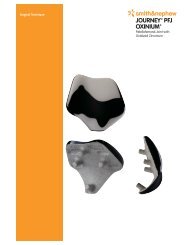Uni- Condylar Knee Surgical Technique - Yorkshire Joint ...
Uni- Condylar Knee Surgical Technique - Yorkshire Joint ...
Uni- Condylar Knee Surgical Technique - Yorkshire Joint ...
You also want an ePaper? Increase the reach of your titles
YUMPU automatically turns print PDFs into web optimized ePapers that Google loves.
Indications, Contra-indications and X-ray Templating<br />
Indications<br />
<strong>Uni</strong>compartmental knee replacement is indicated for<br />
patients with osteoarthritis isolated to the medial or lateral<br />
tibio-femoral compartments. In these cases the remaining<br />
opposite compartment articular cartilage is physically and<br />
biomechanically intact and capable of bearing normal loads.<br />
Contra-indications<br />
UKR is contraindicated in cases of: active local or systemic<br />
infection; loss of musculature, osteoporosis, neuromuscular<br />
compromise or vascular deficiency in the affected limb,<br />
rendering the procedure unjustifiable.<br />
UKR is also contraindicated in patients with over 30° of fixed<br />
varus or valgus deformity.<br />
New <strong>Joint</strong> Line<br />
Tibial resection<br />
Anterior Posterior (A/P) Template: Tibia<br />
Goal: Use the A/P template to visualise and<br />
approximate the level of tibial resection to<br />
re–establish the premorbid articular cartilage<br />
joint line.<br />
The tibial resection is planned at 90° to the long<br />
axis of the tibia with a resection level that allows<br />
the desired thickness of tibial components to be<br />
used (Figure 1). The thinnest metal-backed tibial<br />
implant is 7 mm and the thinnest all-polyethylene<br />
tibial implant is 8 mm.<br />
Figure 1: X-ray template with 7 mm tibial component.<br />
Lateral Template<br />
Goal: Template the lateral X-ray to estimate<br />
femoral component size (Figure 2).<br />
Position the template in the coronal plane at a<br />
right angle to the long axis of the femur. Align<br />
the template with the planned distal femoral cut.<br />
The template outline should be 2 mm larger than<br />
the bony margin of the X-ray to approximate the<br />
outline of the articular surface.<br />
Figure 2: Femoral sizing on the lateral X-ray. Note the<br />
105° posterior resection will not be parallel to the<br />
long axis.<br />
The posterior condyle of the prosthesis should<br />
not overlap the cartilage contour of the adjacent<br />
femoral posterior condyle by more than 2 mm.<br />
Also gauge the posterior slope of the proximal<br />
tibia on the lateral X-ray, with the goal to<br />
reproduce it during the surgery (Figure 3). The<br />
slope has been reported to vary from 0° to greater<br />
than 15° and may affect flexion space tightness.<br />
Figure 3: Posterior tibial slope on the lateral X-ray.<br />
2





